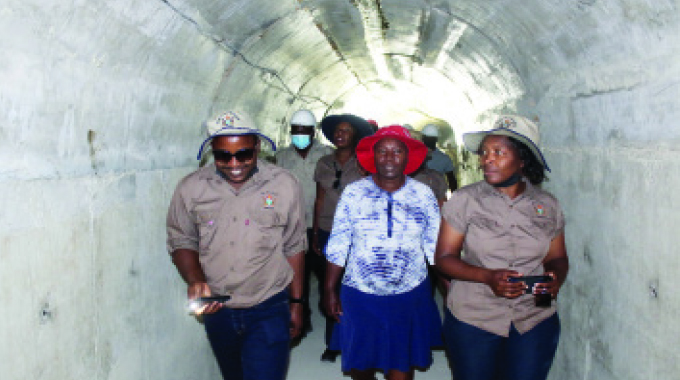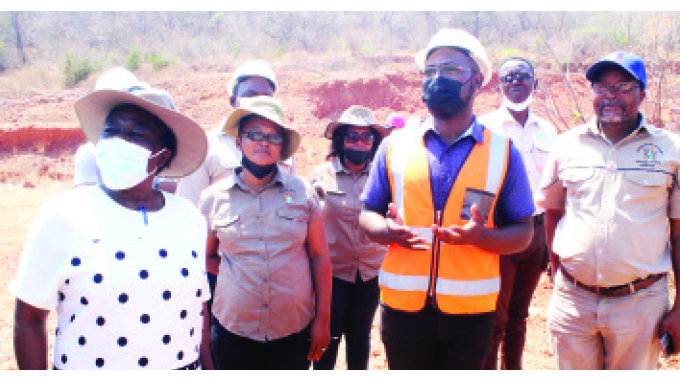The Chronicle

Mashudu Netsianda, Deputy News Editor
THE City of Bulawayo has begun a process to expand critical water treatment and conveyance infrastructure in readiness to receive increased water supplies from the massive Lake Gwayi-Shangani, which will be a lasting solution to the city’s perennial water woes.
The expanded infrastructure will enhance feeding of water from Magwegwe Reservoir into Criterion Water Treatment Works, which will enhance distribution of the precious liquid to critical areas across the city.
Criterion Water Treatment Works is the nerve centre of the city’s water treatment and distribution.
The New Dispensation led by President Mnangagwa is spearheading the construction of the 650 million cubic metres dam that was first mooted in 1912 but had failed to take off under previous successive administrations.
Financed with domestic resources from enhanced fiscal space, construction works are being done simultaneously with the laying of a 245KM pipeline linking Lake Gwayi-Shangani and Bulawayo.
Both projects are expected to create wider economic opportunities and spur increased development in the entire region.
Government has said it is committed to ensure timely project completion to guarantee reliable water supply to Bulawayo for the next 80 years while weaning off some of its supply dams in Matabeleland South to cater for developmental projects in the largely rural province.
On Friday Bulawayo Provincial Affairs and Devolution Minister Judith Ncube toured the Lake Gwayi-Shangani site together with a team from the Bulawayo City Council and expressed satisfaction with progress and work covered so far.
She said the massive project will add economic impetus to the city and help it reclaim its status as the country’s industrial hub.
Adequate water is critical in attracting investment and for years the business community in Bulawayo has been complaining about erratic water supplies.
“I’m quite delighted with what the Government under the Second Republic is doing as far as the Lake Gwayi-Shangani project is concerned. As Bulawayo, I am now optimistic that we will soon start attracting necessary investment in the city, which should restore Bulawayo to its former status of being Zimbabwe’s industrial hub in line with the desire by the Government to transform the country into an upper middle-income economy by 2030,” said Minister Ncube.
She said the purpose of her visit was to appreciate the ongoing works and was amazed with the progress on the ground. Minister Ncube said through the Lake Gwayi-Shangani project, local industries are set to be revived as they will be guaranteed adequate water supplies.
 Part of the delegation in one of the tunnels at the lake
Part of the delegation in one of the tunnels at the lake“This project is a critical component because whenever investors inquire about investment opportunities in Bulawayo, they first want to know about the reliability of water supplies and energy,” she said.
Minister Ncube said the Gwayi-Shangani water project had been on the pipeline since 1912 but it took the able and visionary leadership of President Mnangagwa to bring it into life.
“The surrounding districts, Bulawayo and beyond will benefit from this massive project because of the opportunities created by this project,” she said.
City of Bulawayo’s acting principal engineer for water supplies, Engineer Dhumani Gwetu, said council is already working on putting the associated infrastructure that will result in the distribution of water to the critical areas.
 Zimbabwe National Water Authority (Zinwa)
Zimbabwe National Water Authority (Zinwa)“As Bulawayo City Council we are working with Zinwa behind the scenes. We are looking at the ways of evacuating water when it arrives in Bulawayo. We have been waiting for this project as a city since it will go a long way in alleviating our water challenges,” he said.
Eng Gwetu said putting up the expanded infrastructure is a process, which requires resources and time.
“The city’s water set up is configured with Criterion water works as the nerve centre hence when water from Lake Gwayi-Shangani arrives in Bulawayo, as BCC we are looking at ways of getting that water to Criterion so that it reaches every corner of the city,” he said.
Eng Gwetu said council was in the process of drawing up a budget for the associated infrastructure.
Zinwa assistant resident engineer, Engineer Lucio Chayeruka, said the dam is now at 69 percent complete with contractors having introduced night shifts to ensure work is completed within the agreed time frames.
“We are moving at a fast pace and we are optimistic that we will be able to meet our deadline to supply potable water to Bulawayo and transform irrigation within the corridors of Binga, Lupane and Hwange districts. We are doing at least four metres a month and right now we are at 36 metres of the dam wall”, said Eng Chayeruka.
He said this year alone they covered 17 metres of the height of the dam and to date the overall construction progress is at 69 percent.
“We have 600 workers on site of which 90 percent are locals from Hwange, Lupane and Binga districts,” said Eng Chayeruka.
Chinese engineers, China Water and Electric Corp, won the tender to construct the dam and Zinwa is in charge of the project.
 ZINWA assistant resident Engineer Lucio Chayeruka (in orange vest) gives insight on the dam wall construction to delegates during the tour of Gwayi Shangani dam on Friday. On the left is the Bulawayo Minister of State for Provincial Affairs and Devolution Judith Ncube and Director Economic Affairs and Investment in Office of the President and Cabinet Simon Saunyama. (right)
ZINWA assistant resident Engineer Lucio Chayeruka (in orange vest) gives insight on the dam wall construction to delegates during the tour of Gwayi Shangani dam on Friday. On the left is the Bulawayo Minister of State for Provincial Affairs and Devolution Judith Ncube and Director Economic Affairs and Investment in Office of the President and Cabinet Simon Saunyama. (right)The massive water project is expected to ignite rural industrialisation across the Matabeleland region where communities will have access to clean water and electricity to power local institutions.
Guided by the National Development Strategy (NDS1), the Government aims to increase the percentage of people with access to potable water to 90 percent from 78 percent by 2025.
The construction of the massive water body will transform the Matabeleland region as irrigation projects will be established along the pipeline thereby turning the region into a green belt.
Lake Gwayi-Shangani is part of the National Matabeleland Zambezi Water Project, an idea that was conceived more than a century ago and has only been turned into reality by the Second Republic.
The dam is the third largest in the country after Tugwi-Mukosi and Lake Mutirikwi.
Already, Government has identified 10 000 hectares to be put under irrigation along the pipeline.
The completion of the project will also see the Government constructing a 10-megawatt power station at the massive dam. – @mashnets.
Article Source: The Chronicle
